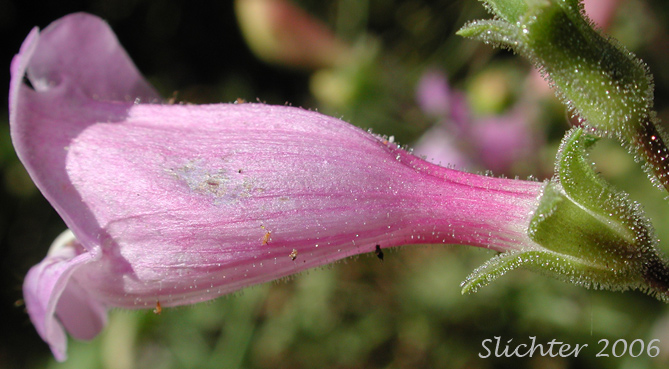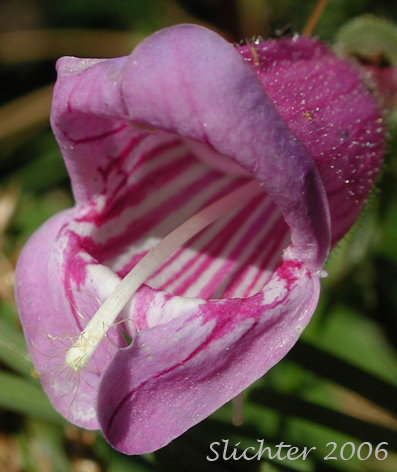
 The photo at right shows a close-up view of the attractive mouth of the corolla of cut-leaf penstemon as seen in the webmaster's garden in Gresham, OR............August 19, 2006. Note that the staminode is flattened in cross-section with a tuft of hairs at its tip, and that it extends out over the lower lip.
The photo at right shows a close-up view of the attractive mouth of the corolla of cut-leaf penstemon as seen in the webmaster's garden in Gresham, OR............August 19, 2006. Note that the staminode is flattened in cross-section with a tuft of hairs at its tip, and that it extends out over the lower lip.
Cut-leaved penstemon is a pretty, late blooming penstemon which does well in rich, well-drained soil in gardens on both sides of the Cascades. It typically consists of numerous stems arising from a shrubby base. It does look like like a large, many-flowered bush once it has established itself. Its height may vary from 20 to 80 cm high. The leaves of the variety shown here (var. richardsonii) are deeply toothed or cleft. The leaves are all found on the stems and are all glabrous or occasionally lightly nonglandular-pubescent. The blades range from 2.5-5 cm long.
The inflorescence is a wide-spaced, somewhat leafy raceme or mixed raceme-panicle. The corollas are glabrous to glandular outside, with pink to blue or lavender tubes. The tube expands to a wide throat but the mouth of the flower is not strongly two-lipped. Prominent dark lines may be found on the palate. The corolla of variety dentatus ranges from longer than 22-32 mm long. The calyx is 4-9 mm long with lance-shaped to ovate sepals, often unequal in size and green or purplish colored. The anther sacs only split 1/3 to 1/2 their length and thus remain horseshoe-shaped. Depending on the variety, the staminode, which is slightly exserted from the tube, may be lightly bearded at the tip or glabrous. The staminode of variety richardsonii is lightly bearded at the tip.
Variety curtiflorus: Corolla 15-20 mm long, the staminode not bearded. Found only in north-central Oregon in Wheeler and Wasco Counties.
Variety dentatus: Corolla 22-32 mm long, the staminode bearded. Leaves mostly ovate in outline, shallow and regularly toothed. The upper surfaces of the leaf blades are gray-pubescent. Found only in northern Oregon from Wasco to Grant and Union Counties.
Variety richardsonii: Corolla 22-32 mm long, the staminode bearded. The leaves narrow and deeply and irregular toothed about halfway to the midrib. Found from southern British Columbia south to the east of the Cascades through the Columbia Basin to northern Oregon.
Cut-leaf penstemon is found in open rocky places, cliffs and rock fall areas.
Cut-leaf penstemon is found from south-central British Columbia through central Washington into northeastern Oregon.
It is found westward in the Columbia River gorge as far as McCord Creek and eastward towards Umatilla, OR.